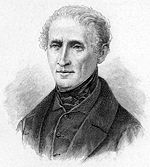Schläft ein Lied in allen Dingen,
die da träumen fort und fort,
Und die Welt fängt an zu singen,
Triffst du nur das Zauberwort.
The 1st stanza of Joseph Freiherr von Eichendorff’s
Die Wünschelrute1

The temptation of second language learners to reach for a dictionary each time they encounter a new word is strong. Rather than seeking to understand the word’s relevance and importance to the understanding of the author’s message, students typically look up the meaning of the word and supply their own interpretation of its relevance and importance. Not surprisingly they often guess right. If the subject matter is new, or the author is alien, however, the chance of misinterpretation of the author’s meaning looms large.
The reason for this temptation is clear; most students are simply incapable of doing otherwise. They do not possess cognizant command of the grammar and morphology of their target language, or even their own for that matter, to perform the needed analysis — namely, walk through the grammatical and morphological logic (the logic of the language) necessary to render the conceptual logic of the author’s message clear. Alas, we, second language learners, are not taught to do what every first-language learner does naturally, and of his own accord: learn the rules that guide the formation and use of each new symbol or set of symbols that we acquire.
In an effort to preserve the integrity of his own language — albeit it, not with the sophisticated erudition of modern linguistics — Dionysius Thrax sought already in the 2nd century BC, somewhat before the Roman invasion of Greece, to elucidate these principles for all language learners .2 Unfortunately today, they are rarely taught to second-language learners with any degree of precision. And, one can only wonder how many first-language learners are sufficiently well-acquainted with these principles to be of any use even in the application of their own language.
form: Form is little more than a symbol — written, drawn, spoken, heard, printed, etched, read, or otherwise created — that we assign, according to a mutually agreed set of morphological rules, to internalized perception of the internal and outside world. With these forms we share our perceptions with others in a manner consistent with our own past, present, and anticipated future surroundings. These symbolic forms are essential, not only because there would be no very useful way to communicate all that we know and feel without them, but also because they play an essential role in how we combine them logically in an effort to express more complex thoughts that extend beyond our immediate knowledge and experience.3
meaning: What most of us look for when we encounter a word whose meaning we do not understand are other symbols that we do understand — symbols that have been logically combined by someone else to explain better the symbol in question.4 In many cases such definitions are sufficient to our understanding of a message; in many cases they are not. The reason for this is simple: we rarely use any word or other symbol in isolation and must nearly always understand a word in its conceptual and grammatical context.5
Although the problem of searching for the meaning of new words through a combination of old words with which we are already familiar is rarely a problem among first language learners, it is often problematic among second language learners who are not well-acquainted with the different forms and meaning that the same word can assume, and who use a set of old words taken from their first language rather than from the language whose word they are trying to understand.[3. This problem will be addressed more thoroughly in a following section entitled the Vocabulary of Grammar.
use: On the one hand, the same form and meaning can be used in different ways, and on the other hand, different, but distinct forms of the same meaning restrict how the word can be used in combination with other words. By way of example, the present participle — a distinct form created from a verb — can be used as part of a verb phrase to form the progressive tense, as an adjective or predicate modifier to modify a noun or pronoun, or as a gerund — a lone noun-subject, noun-object, or effective verb of a gerund phrase that is used in turn as a noun or abbreviated relative clause. In direct contrast, the word excellent is always an adjective or predicate modifier and, when not used as an interjection, can only be used to modify a noun or pronoun. There is no adverbial form for the word. Further, its nominative form excellence can only be used as a noun-subject, noun-object, or predicate nominative — i.e. as a noun!
Conclusion
The first-language learner’s acquisition of the concepts of form, meaning, and use is intuitive in the sense that the learning mechanisms that he employs to distinguish among these notions are built-in. They are closely related to how we conceptualize our perception of the world about us. Though conscious effort is required to wield these notions correctly, they are rarely concepts that are very neatly defined in the minds of those who employ them. This is because our understanding of them is acquired in combination with a whole variety of other notions that we tend to learn in a variety of prescribed patterns.
Upon studied reflection, however, these notions are fairly lucid concepts that can be useful to second-language learners, if only they were clearly taught and repeatedly utilized by second-language teachers each time a new word is introduced. Indeed, examples of different forms and use of the same meaning are only very helpful, if these differences can be clearly identified by the student.
As most second-language learners lack the time and opportunity to engage in the trial-and-error experimentation of young children, it is up to the second-language teacher to provide this clarification; else the student is condemned to the memorization of patterns whose use is limited to the context in which they are learned — a context that is nearly always void of real substance and must be translated in order to be understood as a result.
- There is a song in every thing,
In dreamy slumber that awaits
The magic word for you to sing,
And all the world resonates.
Translation by Roddy A. Stegemann, Summer 2016 ↩ - Dionysios Thrax lived in Alexandria (a city located in the north of present day Greece) where he studied under Aristarchus of Samothrace (ca. 217 BC – 145 BC), a librarian and the founder of the School of Aristarcheans. Dionysios is credited with the writing of the first Western grammar known in at least one translation as, The Art of Grammar. Although not his only work, it appears to be his most famous, for in it he sets forth the foundation for what we call today the Parts of Speech. In addition, Dionysius is reported to have taught in Rome as a public professor during the time of Pompey, the Great (106 BC – 48 BC). Taken from Thomas Davidson. 1874. The Grammar of Dionysios Thrax. St. Louis, Missouri: R. P. Studley Co. ↩
- For a good discussion on the origin of the symbol see Lesley A. White’s “The Symbol: The Origin and Basis of Human Behavior” in Philosophy of Science, Vol. 7, No. 4 (Oct., 1940), pp. 451-463. <online document> White’s treatment of the symbol is to culture, what Ludwig von Mises’ treatment of the origin of money is to the origination of markets. ↩
- All symbols are abstract in the sense that they are symbolic representations of something else. Some symbols, however, are based entirely on perception, whereas others are based on other symbols, or some combination of these and direct perception. Typically, we refer to symbols that are logically, or less commonly illogically, constructed from other symbols as being abstract. ↩
- Language is first and foremost conceptual insofar as it utilizes abstract symbols to communicate information. It is a form of mental activity very different from its affective (emotional) counterpart. This is not to say that we cannot express emotion conceptually, because we certainly have symbols (words) to do this very thing. Simply, it is one thing to talk or read about the cry of anguish of another; it is quite another thing to experience the same cry in real life. ↩
